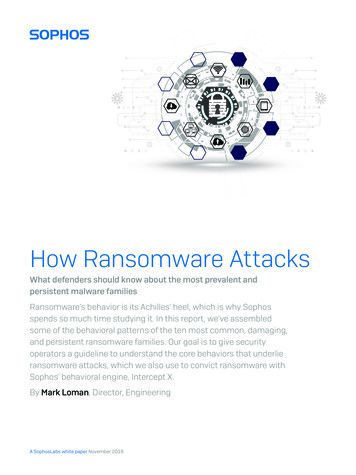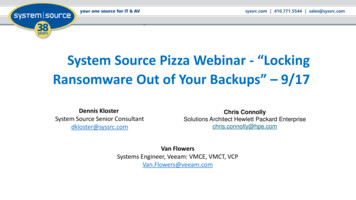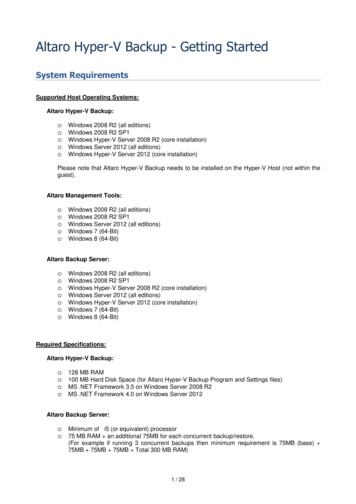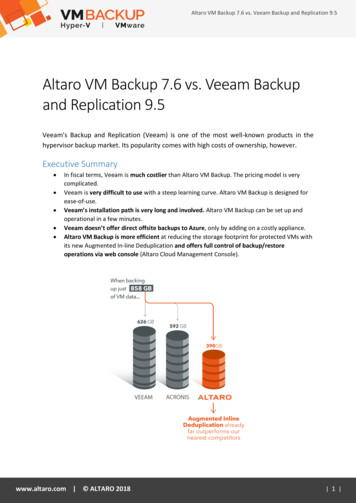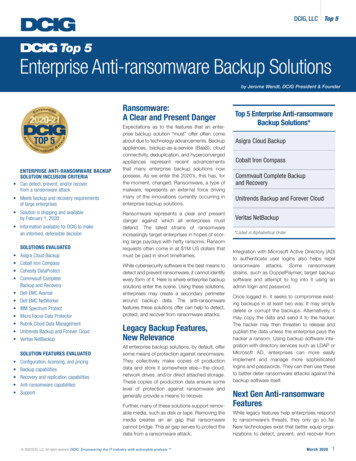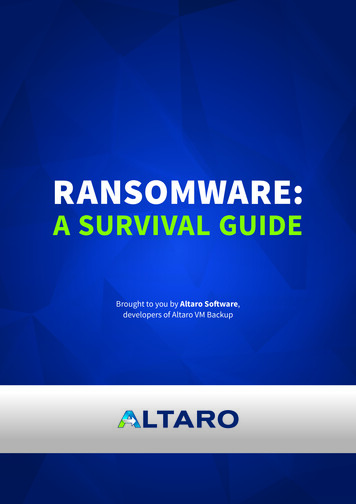
Transcription
RANSOMWARE:A SURVIVAL GUIDEBrought to you by Altaro Software,developers of Altaro VM Backup
TABLE OF CONTENTSEXECUTIVE SUMMARY.3INTRODUCTION.4RANSOMWARE EXPLAINED.5HISTORY AND MAJOR VERSIONS.7AIDS/PC 8Cerber.8WHY ANTIVIRUS SOFTWARE ALONE IS NOT SUFFICIENT.9WHAT TO LOOK FOR. 10Ransom demands. 10Threats from “Legal Authorities”. 11Inaccessible files. 12User reports. 12Log files. 12PROTECTION STRATEGIES, OR THE BEST DEFENSE IS A LAYERED DEFENSE. 13Limiting user rights. 13Antimalware software. 13Blocking attachments. 13Execution control. 14Scanning downloads. 14Implement, and use, PAWS. 15Use Exchange Online Protection with Advanced Threat Protection. 15Plan for future. 15User training. 15MITIGATION STRATEGIES, OR HOW DO I LIMIT THE DAMAGE?. 17Least privilege. 17Backups, backups, backups. 17Insurance. 20REACTION STRATEGIES, OR WHAT DO I DO KNOW?. 22Single workstation falls victim, local data only with backups. 22Single workstation falls victim, local and network data with backups. 23Multiple workstations fall victim, data has backups. 24Anything falls victim and you don’t have a backup. 24CLOSING REMARKS. 26ADDITIONAL RESOURCES. 27ABOUT ALTARO. 28FREE VM BACKUPMore info & DownloadLike this ebook?SHARE IT!2
EXECUTIVE SUMMARYOne of the most devastating and prevalent forms of malware threatening consumersand enterprises today is ransomware. The pervasive and damaging type of malwareencrypts data and holds it for ransom, extorting victims to pay up or lose out. In thise-book, you will learn about ransomware, how to defend yourself and your usersagainst it, and how to respond should you fall victim to it. At the end of this guide youwill also find additional resources and material to learn more.FREE VM BACKUPMore info & DownloadLike this ebook?SHARE IT!3
INTRODUCTIONRansomware – it’s a name that conveys a lot about what can potentially be the mostdevastating form of malware you might ever encounter. Ransomware is malicioussoftware that parses your local hard drive, any attached removable storage, and evenmapped network drives for your data. When it finds data files, like images and mediaand documents and databases and presentations and more, it encrypts them so thatyou cannot access them. It then provides you with an ultimatum-pay up, or kiss yourdata goodbye. While it may be a pain to have to format your computer and reinstallyour operating system and all your apps when normal malware hits, that effort is atleast manageable. But when irreplaceable photos and videos, or documents you’vespent days to weeks creating, or databases containing information you cannot possiblyrecreate are gone, what can you do? Ultimately, you can either choose to lose that data,or pay off the attackers’ ransom demands.The problem is particularly challenging to deal with when the malware used todistribute the ransomware is so new that it constitutes a “zero-day attack.” Zero-daymalware is so new that traditional antivirus software, which use signature files toidentify known malware, do not detect it.When attackers combine this zero-day malware with targeted attacks on your business,known as spear phishing attacks, you can quickly find yourself in a very bad situation.But take heart, as this is not a lost cause nor reason to cancel your Internet circuit andgo back to paper and pen. There are several things end users and businesses can do tohelp avoid becoming a victim, as well as strategies you can employ to recover withouthaving to pay up. Keep reading to learn more!FREE VM BACKUPMore info & DownloadLike this ebook?SHARE IT!4
RANSOMWARE EXPLAINEDRansomware is a type of malware that is becoming more and more common lately.Wikipedia’s page on ransomware defines it as “a Cryptovirology attack carried out usingcovertly installed malware that encrypts the victim’s files and then requests a ransompayment in return for the decryption key that is needed to recover the encryptedfiles.” Microsoft’s blog post on ransomware defines it as “Ransomware is a type ofmalware that holds computers or files for ransom by encrypting files or locking thedesktop or browser on systems that are infected with it, then demanding a ransom inorder to regain access.” Both are accurate, but really don’t convey the nastiness that isransomware. Consider all the data on your computer, or that you have Change accessto on the network. That could be your kid’s first birthday party or their high-schoolgraduation, or the video of your wedding, or your tax returns for the past five years, orthe only surviving copy of your grandmother’s best recipes. Or, it could be the RFP fromyour largest customer, or the secret formula for your company’s best product, or thatworkbook you base your business predictions on that has evolved over the past fiveyears and which you cannot function effectively without.Whatever that data is imagine that I took it from you. I dangle it in front of you, anddemand that you give me your lunch money or I will drop it into the toilet and flush itaway forever. It’s right there. You can see it. But you cannot do anything about it exceptpay up. That’s what ransomware is. It’s an Internet bully blackmailing you for yourlunch money, but on a cyber scale.Ransomware encrypts your data using algorithms that cannot be cracked or reversedin practical terms. We’re not talking about password protecting a Word document.We’re talking about applying things like AES 256 or other strong encryption to all ofyour critical data, using a key that is unique to you. Either you pay up, or you lose thedata. No one is going to brute force the password, or figure out a way to reverse it foryou. You can’t go online to find someone else who fell victim, paid up, then posted thepassphrase online so you wouldn’t have to do the same thing. You can either pay up, orconsider all of the encrypted data to be gone baby gone and lost forever.Some ransomware just renders your files inaccessible, with a text file left in thedirectory for you to find in order to read the ransom note. Others can open a webFREE VM BACKUPMore info & DownloadLike this ebook?SHARE IT!5
browser and open the ransom note from a web server, or pop up a dialog box. Themost recent, Cerber, went so far as to include an audio ransom note. However, a victimbecomes aware of the fact that they are now in a bad way, the ransom demands havesome things in common. Tim Rains of Microsoft recent published a blog post entitled“Ransomware: Understanding the Risk” which summarizes the common elements ofransomware very well. Common elements in ransom notes include: making encrypted data unrecoverable after a certain period of time threatens to post captured data publicly claims to be law enforcement and threaten prosecution an increasing cost for the ransom the longer the user waits to pay up threats to render the machine unbootable threats to erase all data and render all enterprise computers inoperable demands payment through various difficult or impossible to trace methods, withBitcoin being the most common today.Users can pay up in the hope that they get the decryption key, or they can flatten theirsystems and start over again, hopefully restoring their data from backup. If they chooseto pay, they may have to visit a website linked in the ransom note in order to processthe payment. They may or may not receive the decryption key as soon as they enterpayment that’s of course another risk. You pay up, and are still out your data.Let’s look more closely at some of the major ransomware variants that are in the wild.FREE VM BACKUPMore info & DownloadLike this ebook?SHARE IT!6
HISTORY AND MAJOR VERSIONSRansomware is not exactly new, but it’s definitely experiencing a surge in commonality.The first known and documented ransomware was all the way back in 1989, with apiece of malware known as both AIDS and PC Cyborg. 2005 saw more ransomware withseveral different types in the wild that were both more widespread and sophisticated.Ransomware “hit the big time” in 2013 with Cryptolocker, a type of malware that madewidespread news and is estimated to have netted attackers millions of dollars. Let’stake a closer look at some of the most significant versions of ransomware since 2005.AIDS/PC CYBORGKnown by both names, this ransomware was allegedly written and used by a singleindividual, Joseph Popp, in 2005. AIDS would both encrypt and hide files and demanda US 189 ransom to regain access to the data. Popp was arrested but found unfit tostand trial. Interestingly, AIDS used symmetric key encryption, and the key was storedin the code of the malware. Of course, for most of his victims, this made no difference.GPCODEFirst appearing around 2005, there have been numerous variants of Gpcode. Earlyversions used symmetric key encryption and/or deleted the unencrypted versions offiles, making it fairly easy for some users to recover their data without paying the 100to 200 ransom demand left in TXT files in each directory. Others used a proprietaryalgorithm which was flawed and quickly broken by researchers. As Gpcode evolved,it started to use asymmetric encryption and proper encryption algorithms such asRSA and/or AES, and overwriting the unencrypted files to prevent recovery withoutpayment.REVETONIn 2012, the ZeuS botnet gave rise to the Citadel Trojan which was used to spreadReveton, a piece of ransomware with a new twist started to hit mostly Europeanvictims. Purporting to be from a law enforcement agency, and frequently brandedor customized to the region the victim was in, this ransomware claimed that illegalcontent had been found or illegal activity detected, and fines had to be paid to theparticular law enforcement agency to unlock the computer. Of course, these “fines”had to be paid through various online and anonymous means. The warnings frequentlyincluded the victim’s IP address to convey legitimacy, and some even took images fromthe victims’ webcam to appear as if the user was under surveillance. In a twist of fatethat shows even some of the darkest clouds have silver linings, one victim was actuallyFREE VM BACKUPMore info & DownloadLike this ebook?SHARE IT!7
guilty of child pornography and turned himself in to his local law enforcement. Severalarrests have been made in connection to Reveton but it is still in the wild with newvariants cropping up.CRYPTOLOCKERRansomware became a part of practically every computer users’ vocabulary with theappearance of CryptoLocker in 2013. Using asymmetric encryption, overwriting theunencrypted files, demanding ransom payable in the untraceable crypto-currencyBitcoin, and spawning multiple variants including some ransomware as a service,it’s estimated that victims have paid US 27 million in ransom since CryptoLockerfirst struck. The original CryptoLocker was eventually shut down when a cooperativeoperation between several law enforcement and industry players took down the ZeuSbotnet, but new variants continue to crop up.CRYPTOWALLBecoming prominent in 2014, one of CryptoWall’s most common distributionmethods was through malvertising on the Zedo ad network. Countless sites wereunwittingly contributing to the spread by hosting ads they didn’t even realize werebad. CryptoWall has evolved a few times, and includes spreading through Javascript inemail attachments, and the ability to encrypt not only files but also the shadow copiescreated by the Windows Volume Shadow copies, as well as installing malware to stealpasswords and Bitcoin wallets.CERBERThe most recent ransomware is known by several names, including Cerber. Thismalware typically spreads through email, and after encrypting your files, plays anaudio file as well as displaying its ransom demands on screen. It provides very detailedinstructions on how to obtain a Bitcoin wallet, purchase Bitcoins, and pay up to getyour decryption keys. All in all, it’s very thorough. It has also been observed to connectto remote systems through the Tor network, but whether that is for registering anothervictim or loading other malware has not been confirmed.FREE VM BACKUPMore info & DownloadLike this ebook?SHARE IT!8
WHY ANTIVIRUS SOFTWARE ALONEIS NOT SUFFICIENTMany users may think that as long as they have antivirus software, they should beprotected. If only it were that easy. There are two main problems with antivirussoftware. One is straightforward to address, though not that easy. Older ransomwarecan be caught by your antivirus software, but that usually depends upon signature filesto catch malicious code before you run it. The first problem posed by that is dependingupon users, especially end users at home, to run antivirus software, keep it current, andset it to scan all files on access. Getting users to buy antivirus software after the freetrial is up is hard enough, but if they think antivirus software slows their system down,they are just as likely to disable or uninstall it, rendering it worse than worthless sincemost users will act as if they have antivirus software and take unnecessary risks.The second problem with antivirus software is that if it depends upon signatures todetect malware, then it must have an up to date signature file. That means that themalware has to have been around long enough to be detected, and added to thesignature file. Often, ransomware and zero-day attacks go in the same breath, meaningthat the particular ransomware is so new that there is no signature file for it. Whenyou download an infected file or receive an infected attachment for which there is nosignature, your files are encrypted before you know what has happened.Admins may think that antivirus software on their servers will protect them fromransomware if it gets into their environment through a user’s system. If only it were so.Ransomware running on a client PC that is accessing data on file shares to encrypt itlooks, to antivirus software running on the server, no different from legitimate access byusers to that data. If the user has Change permissions to the data, then the malware willbe able to encrypt the data stored on the servers, without triggering any response fromantimalware software running in the server. Your sysadmins think they are protected but they aren’t.FREE VM BACKUPMore info & DownloadLike this ebook?SHARE IT!9
WHAT TO LOOK FORThe biggest problem with looking for signs that ransomware is running rampantsomewhere in your environment is that the symptoms are all there after the damageis done. Anything you could look for to determine if ransomware is present will onlybe there as a result of the malware having already encrypted your files. However, thequi
methods was through malvertising on the Zedo ad network. Countless sites were unwittingly contributing to the spread by hosting ads they didn’t even realize were bad. CryptoWall has evolved a few times, and includes spreading through Javascript in email attachments, and the abi
